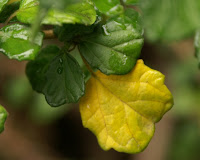
I was cruising the back 40 on this mid-March leaf day, and found the hollyhock leaves liberally sprinkled with rust pustules. The browner dots are riper pustules full of spores ready, willing and able to spread to another susceptible plant nearby via splashing rain (or hose water--Doh!) and air currents. The rust most likely came from the stalk and a few dead leaves of the hollyhock that I did not realize would serve nicely as an overwintering spot. The neighbor's hollyhock (source of last year's hollyhock weevils) has no rust whatsoever so I can't blame my rust on that. Hollyhock rust is a fungus (Puccinia malvacearum) that infects hollyhock and other members of the mallow family. Drat!
So I must be checking the other malvaceous plants in the garden. On the hollyhock, it shows up on the upper leaf surface as yellow spots and the lower leaf as shown in the top photo. The blue hibiscus (Aly
 ogyne
ogyne huegelii), yellow mallow (Pavonia praemorsa), and our friend the cheeseweed (Malva neglecta) all had some bright yellow older leaves, a sign the plants are growing and pushing off the old in favor of the vigorous. The tree mallow (Lavatera maritima) and the cape mallow (anisodontea) had some dull yellow leaves, a result of their recent transplanting but again nothing to worry about and no sign of rust pustules. Sadly, the Indian mallow (Abutilon palmeri) that was my pride and joy has met its demise; nothing to do with rust but everything to d
huegelii), yellow mallow (Pavonia praemorsa), and our friend the cheeseweed (Malva neglecta) all had some bright yellow older leaves, a sign the plants are growing and pushing off the old in favor of the vigorous. The tree mallow (Lavatera maritima) and the cape mallow (anisodontea) had some dull yellow leaves, a result of their recent transplanting but again nothing to worry about and no sign of rust pustules. Sadly, the Indian mallow (Abutilon palmeri) that was my pride and joy has met its demise; nothing to do with rust but everything to d o with root rot and the fate of a short-lived plant pushed past its climatic preferences. Good news: none of the other susceptible plants have rust infection as of now. But those spores are tricky and the weather has been moist.
o with root rot and the fate of a short-lived plant pushed past its climatic preferences. Good news: none of the other susceptible plants have rust infection as of now. But those spores are tricky and the weather has been moist.So I covered the hollyhock plant along with its rust with a plastic bag, dug out the root and discared the whole mess clean away from my other mallows. I think I'll turn the soil in that spot and spread some mulch to keep any wayward spores from being splashed onto the Pavonia that is oh so close by. Anyway, aren't hollyhocks supposed to be biannual? Why are they coming up again this year after blooming last? As I think I said before, that (growing hollyhocks) was fun, but I think I'm over them. Cheeseweed often gets blamed for being a reservoir of rust that infects hollyhocks; I suspect if cheeseweed had an agent, the story might be told the other way around.

No comments:
Post a Comment